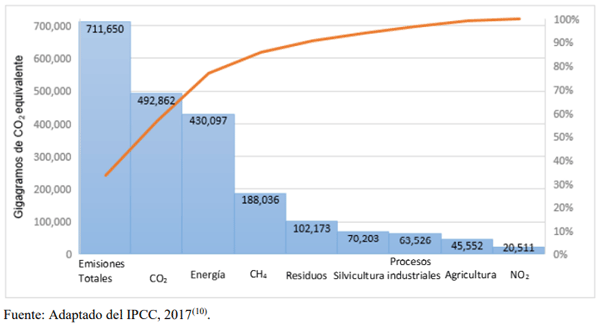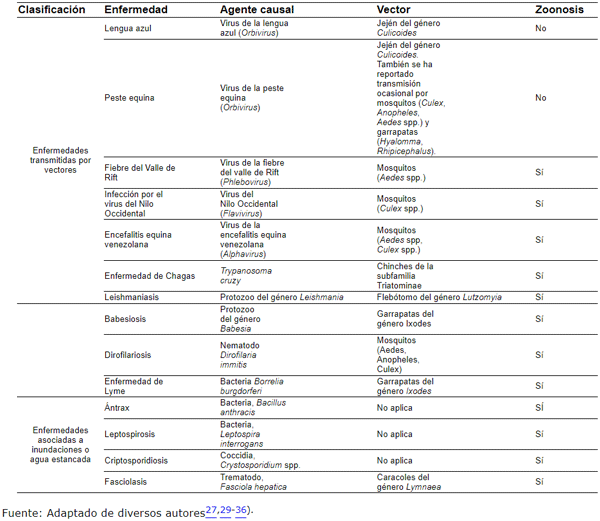Causas y consecuencias del cambio climático en la producción pecuaria y salud animal. Revisión
La acumulación de gases de efecto invernadero en la atmósfera terrestre está ocasionando un cambio climático con graves implicaciones, como fenómenos meteorológicos extremos, cambios en la función y composición de los ecosistemas. Debido a su importancia, resulta relevante analizar el impacto del cambio climático en los sistemas de producción pecuarios. Un área que requiere especial atención es precisamente la salud animal, la emergencia y reemergencia de enfermedades vectoriales en numerosas regiones del planeta constituye un claro ejemplo de asociación entre cambio climático y efectos sobre la interfaz de la salud humana/animal. Dichas afectaciones a la salud animal pueden obedecer a múltiples factores sociales y medioambientales, provocando las llamadas “enfermedades de la producción”, los cuales influencian la aparición de enfermedades emergentes. Sin embargo, cada región y cada sistema de producción tiene sus propias vulnerabilidades. Estos aspectos deben tomarse en cuenta para diseñar mapas de riesgos locales y regionales; así como diseñar, instrumentar y socializar eficientemente procesos de manejo de riesgos ante enfermedades.
Palabras clave cambio climático; enfermedades animales; producción pecuaria; medidas de adaptación


Rev. mex. de cienc. pecuarias vol.11 supl.2 Mérida mar. 2020 Epub 30-Jun-2020
1. Ogden NH, Lindsay LR. Effects of climate and climate change on vectors and vector-borne diseases: Ticks are different. Trends Parasitol 2016;32(8):646-656. https://doi.org/10.1016/j.pt.2016.04.015 [ Links ]
2. Tercera Comunicación Nacional de Cambio Climático ante la Convención Marco de las Naciones Unidas sobre Cambio Climático. IDEAM. Instituto de Hidrología, Meteorología y Estudios Ambientales. México 2017. http://documentacion.ideam.gov.co/cgibin/koha/opacdetail.pl?biblionumber=38147. [ Links ]
3. Patz JA, Epstein PR, Burke TA, Balbus JM. Global climate change and emerging infectious diseases. JAMA, 1996;275(3):217-223. [ Links ]
4. Field CB, Barros VR, Dokken DJ, Mach KJ, Mastrandrea MD, Bilir TE, et al. White LL. (eds.). IPCC: Climate Change 2014: Impacts, adaptation, and vulnerability. Part A: Global and sectoral aspects. Contribution of Working Group II to the Fifth Assessment Report of the Intergovernmental Panel on Climate Change. Cambridge, United Kingdom and New York, NY, USA: Cambridge University Press; 2014. [ Links ]
5. Rosenzweig C, Hillel D. Climate change and the global harvest: potential impacts of the greenhouse effect on agriculture. Oxford University Press; 1998:324. [ Links ]
6. Seinfeld JH, Pandis SN. Atmospheric chemistry and physics from air pollution to climate change. New York. John Wiley and Sons, Incorporated; 1998. [ Links ]
7. Protocolo de Kyoto de la Convención Marco de Las Naciones Unidas sobre el cambio climático. Naciones Unidas. 1998. [ Links ]
8. Hansen JE, Sato M. Trends of measured climate forcing agents. Proc Nat Acad Sci. United States of America 2001;98(26);14778-14783. [ Links ]
9. Watson RT, Rodhe H, Oeschger H, Siegenthaler U. Greenhouse gases and aerosols. In: Climate change: the IPCC Scientific Assessment. Houghton JT, et al, editors. Cambridge: Cambridge University Press; 1990. [ Links ]
10. IPCC (Intergovernmental Panel on Climate Change) 2016. https://www.ipcc.ch/ . Consultado 10 Feb, 2017. [ Links ]
11. Convención Marco de las Naciones Unidas sobre el Cambio Climático y su Protocolo de Kioto. (CMNUCC ) (CMNUCC ) https://www.gob.mx/semarnat/acciones-y-programas/convencion-marco-de-las-naciones-unidas-sobre-el-cambio-climatico-y-su-protocolo-de-kioto-cmnucc?idiom=es Consultado 7 Feb, 2017. [ Links ]
12. FAO. Food and Agriculture Organization of the United Nations. La ganadería a examen. Estado mundial de la agricultura y la alimentación. Roma. 2009. http://www.fao.org/docrep/012/i0680s/i0680s.pdf. [ Links ]
13. OMM (Organización Meteorológica Mundial). 2015. Boletín sobre los gases de efecto invernadero. https://www.wmo.int/media/es/content/las-concentraciones-de-gases-de-efecto-invernadero-vuelven-batir-un-r%C3%A9cord . Consultado 4 Feb, 2017. [ Links ]
14. FAO. Food and Agriculture Organization of the United Nations. La larga sombra del ganado: problemas ambientales y opciones. Roma. 2009. http://www.fao.org/docrep/011/a0701s/a0701s00.htm. [ Links ]
15. FAO. Food and Agriculture Organization of the United Nations. Tackling Climate Change Through Livestock. A global assessment of emissions and mitigation opportunities Roma. 2013. http://www.fao.org/docrep/018/i3437e/i3437e00.htm. [ Links ]
16. Grain. Campo y crisis climática. Soberanía Alimentaria. Biodiversidad y Culturas. Barcelona. 2010. [ Links ]
17. Barbier EB. Agricultural expansion, resource booms and growth in Latin America: Implications for long-run economic development. World Develop 2004;32(1):137-157. [ Links ]
18. Oyhantçabal W, Vitale E, Lagarmilla P. El cambio climático y su relación con las enfermedades animales y la producción animal. En: Compendio de los temas técnicos presentados ante la Asamblea mundial de los delegados o a las Comisiones regionales de la OIE-2009, Paris: Organización Mundial de Sanidad Animal (OIE); 2010:169-177. [ Links ]
19. Lorente-Saiz A. Ganadería y cambio climático: una influencia recíproca. GeoGraphos. Revista Digital para Estudiantes de Geografía y Ciencias Sociales 2010;1(3):1-22. http://web.ua.es/revista-geographos-giecryal. [ Links ]
20. Bravo-Ortega C, Lederman D. Agriculture and national welfare around the world: Causality and international heterogeneity since 1960. World Bank Policy Research Working Paper. 2005. [ Links ]
21. Ardila A, Wilson V. El sector pecuario frente al cambio climático: una realidad incómoda. Rev Cienc Anim 2012;(5):107-120. [ Links ]
22. Oswald Ú. Cambio climático, conflictos sobre recursos y vulnerabilidad social. En Delgado GC, Gay C (coordinadores). México frente al cambio climático. Retos y oportunidades, UNAM, México. 2010:51-83. [ Links ]
23. IPCC. Intergovernmental Panel on Climate Change Climate Change 2014: Synthesis Report. Contribution of Working Groups I, II and III to the Fifth Assessment Report of the Intergovernmental Panel on Climate Change. Geneva, Switzerland. 2014. http://www.ipcc.ch/report/ar5/wg3/ [ Links ]
24. Fischer G, Shah M, Tubiello FN, Van-Velhuizen H. Socio-economic and climate change impacts on agriculture: an integrated assessment, 1990-2080. Philosophical Transactions of the Royal Society of London. Series B, Biological Sciences 2005;360(1463):2067-2083. https://doi.org/10.1098/rstb.2005.1744. [ Links ]
25. Mendelsohn R. The impact of climate change on agriculture in developing countries. J Nat Resour Policy Res 2008;1(1):5-19. https://doi.org/10.1080/19390450802495882 [ Links ]
26. Porretta D, Mastrantonio V, Amendolia S, Gaiarsa S, Epis S, Genchi C, et al. Effects of global changes on the climatic niche of the tick Ixodes ricinus inferred by species distribution modelling. Parasites & Vectors 2013;(6):271. https://doi.org/10.1186/1756-3305-6-271. [ Links ]
27. Lubroth J. Climate change and animal health. En: FAO: Building resilience for adaptation to climate change in the agriculture sector. Roma. 2012:63-70. [ Links ]
28. King L. What is one health and why is it relevant to food safety? Workshop Improving Food Safety Through One Health, Forum on Microbial Threats; Washington, DC: Institute of Medicine; 2011. [ Links ]
29. Black P, Nunn M. Repercusiones de los cambios climáticos y medioambientales en las enfermedades animales emergentes y reemergentes y en la producción animal. Conf. OIE 2009:27-39. [ Links ]
30. Feria-Arroyo TP, Castro-Arellano I, Gordillo-Pérez G, Cavazos AL, Vargas-Sandoval M, Grover A, et al. Implications of climate change on the distribution of the tick vector Ixodes scapularis and risk for Lyme disease in the Texas-Mexico transboundary region. Parasites & Vectors 2014:7-199. https://doi.org/10.1186/1756-3305-7-199 [ Links ]
31. Gilbert L. Altitudinal patterns of tick and host abundance: a potential role for climate change in regulating tick-borne diseases? Oecologia 2010:162 (1):217-225. https://doi.org/10.1007/s00442-009-1430-x [ Links ]
32. Shuman EK. Global climate change and infectious diseases. New England J Medicine 2010;362(12):1061-1063. https://doi.org/10.1056/NEJMp0912931 [ Links ]
33. Shope R. Global climate change and infectious diseases. Environmental Health Perspectives 1991;(96):171-174. [ Links ]
34. McBean G. Climate change: Global risks, challenges and decisions. Eos Trans. AGU, 2012;93(18):182. [ Links ]
35. Colwell DD, Dantas-Torres F, Otranto D. Vector-borne parasitic zoonoses: emerging scenarios and new perspectives. Vet Parasitol 2011;182(1):14-21. https://doi.org/10.1016/j.vetpar.2011.07.012. [ Links ]
36. Mills JN, Gage KL, Khan AS. Potential influence of climate change on vector-borne and zoonotic diseases: a review and proposed research plan. Environment Health Perspect 2010;118(11):1507-1514. https://doi.org/10.1289/ehp.0901389 [ Links ]
37. Cumming GS. Comparing climate and vegetation as limiting factors for species ranges of African ticks. Ecology 2002;83(1):255-268. https://doi.org/10.2307/2680136. [ Links ]
38. Wu X, Lu Y, Zhou S, Chen L, Xu B. Impact of climate change on human infectious diseases: Empirical evidence and human adaptation. Environment Int 2015;86:14-23. [ Links ]
39. Rossati A. Global warming and its health impact. Int J Occupat Environment Med 2017;8(1-963):7-20. [ Links ]
40. Baylis M, Githeko AK. The effects of climate change on infectious diseases of animals. Report for the Foresight Project on Detection of Infectious Diseases, Department of Trade and Industry. UK: UK Government. 2006. [ Links ]
41. Brault AC, Powers AM, Ortiz D, Estrada-Franco JG, Navarro-Lopez R, Weaver SC. Venezuelan equine encephalitis emergence: enhanced vector infection from a single amino acid substitution in the envelope glycoprotein. Proc Nat Acad Sci. United States of America 2004;101(31),11344-11349. https://doi.org/10.1073/pnas.0402905101. [ Links ]
42. Gale P, Drew T, Phipps LP, David G, Wooldridge M. The effect of climate change on the occurrence and prevalence of livestock diseases in Great Britain: a review. J Appl Microbiol 2009;106(5):1409-1423. https://doi.org/10.1111/j.1365-2672.2008.04036.x [ Links ]
43. Lindahl JF, Grace D. The consequences of human actions on risks for infectious diseases: a review. Infection Ecology & Epidemiology 2015:5. https://doi.org/10.3402/iee.v5.30048 [ Links ]
44. Forrest HL, Webster RG. Perspectives on influenza evolution and the role of research. Anim Health Res Rev 2010;11(1):3-18. https://doi.org/10.1017/S1466252310000071 [ Links ]
45. Thornton PK, Steeg J. Van de Notenbaert A, Herrero M. The impacts of climate change on livestock and livestock systems in developing countries: A review of what we know and what we need to know. Agric Syst 2009;01(3):113-127. http://dx.doi.org/10.1016/j.agsy.2009.05.002 [ Links ]
46. Dantas-Torres F, Figueredo LA, Otranto D. Seasonal variation in the effect of climate on the biology of Rhipicephalus sanguineus in southern Europe Parasitology 2011;138(4): 527-536. https://doi.org/10.1017/S0031182010001502 [ Links ]
47. Estrada-Peña A, Gray JS, Kahl O, Lane RS, Nijhof AM. Research on the ecology of ticks and tick-borne pathogens--methodological principles and caveats. Frontiers Cellular Infection Microbiol 2013;3:29. https://doi.org/10.3389/fcimb.2013.00029 [ Links ]
48. Jore S, Vanwambeke SO, Viljugrein H, Isaksen K, Kristoffersen AB, Woldehiwet Z, et al. Climate and environmental change drives Ixodes ricinus geographical expansion at the northern range margin. Parasites & Vectors 2014;7:11. https://doi.org/10.1186/1756-3305-7-11 [ Links ]
49. Gallana M, Ryser-Degiorgis MP, Wahli T, Segner H. Climate change and infectious diseases of wildlife: Altered interactions between pathogens, vectors and hosts. Current Zoology 2013;59(3):427-437. https://doi.org/10.1093/czoolo/59.3.427 [ Links ]
50. Black PF, Butler CD. One Health in a world with climate change. Revue Scientifique et Technique (International Office of Epizootics) 2014;33(2):465-473. [ Links ]
51. Secretaría de Salud.2013 Norma Oficial Mexicana NOM-017-SSA2-2012, para la vigilancia epidemiológica. [ Links ]
52. Sosa-Gutiérrez CG, Solórzano-Santos F, Walker DH, Torres J, Serrano CA, Gordillo-Pérez G. Fatal monocytic ehrlichiosis in woman, México, 2013. Emerg Infect Diseases 2016;22(5):871-874. https://doi.org/10.3201/eid2205.151217 [ Links ]
53. De la Fuente J, Kocan KM. Strategies for development of vaccines for control of ixodid tick species. Parasite Immunol 2006;28(7):275-283. https://doi.org/10.1111/j.1365-3024.2006.00828.x [ Links ]
54. Parham PE, Waldock J, Christophides GK, Hemming D, Agusto F, Evans KJ, et al. Climate, environmental and socio-economic change: weighing up the balance in vector-borne disease transmission. Philosoph Transact Royal Soc of London. Series B, Biological Sci 2015;370:(1665). https://doi.org/10.1098/rstb.2013.0551 [ Links ]
55. Medlock JM, Leach SA. Effect of climate change on vector-borne disease risk in the UK. Lancet Infectious Diseases 2015;15(6):721-730. https://doi.org/10.1016/S1473-3099(15)70091-5. [ Links ]
56. Jaenson TG, Hjertqvist M, Bergström T, Lundkvist Å. Why is tick-borne encephalitis increasing? A review of the key factors causing the increasing incidence of human TBE in Sweden(a). Parasites & Vectors 2012;5:184. https://doi.org/10.1186/1756-3305-5-184 [ Links ]
57. Korotkov Y, Kozlova T, Kozlovskaya L. Observations on changes in abundance of questing Ixodes ricinus, castor bean tick, over a 35-year period in the eastern part of its range (Russia, Tula region). Med Vet Entomol 2015;29(2):129-136. https://doi.org/10.1111/mve.12101 [ Links ]
58. Dennis DT, Nekomoto TS, Victor JC, Paul WS, Piesman J. Reported distribution of Ixodes scapularis and Ixodes pacificus (Acari: Ixodidae) in the United States. J Medic Entomol 1998;35(5):629-638. [ Links ]
59. Bertrand MR, Wilson ML. Microclimate-dependent survival of unfed adult Ixodes scapularis (Acari:Ixodidae) in nature: life cycle and study design implications. J Medic Entomol 1996;33(4):619-627. [ Links ]
60. Fish D. Population ecology of Ixodes damini. In: Ecology and environmental management of Lyme disease. New Brunswick, NJ: Rutgers University Press; 1993:25-42. [ Links ]
61. Gordillo-Pérez G, Vargas M, Solórzano-Santos F, Rivera A, Polaco OJ, Alvarado L, et al. Demonstration of Borrelia burgdorferi sensu stricto infection in ticks from the northeast of Mexico. Clinical Microbiol Infection: European Soc Clinical Microbiol Infect Diseases 2009;15(5):496-498 https://doi.org/10.1111/j.1469-0691.2009.02776.x [ Links ]
62. Medlock JM, Hansford KM, Bormane A, Derdakova M, Estrada-Peña A, George JC, et. al. Driving forces for changes in geographical distribution of Ixodes ricinus ticks in Europe. Parasites & Vectors 2013;6(1):1. https://doi.org/10.1186/1756-3305-6-1 [ Links ]
63. Boeckmann M, Joyner, TA. Old health risks in new places? An ecological niche model for I. ricinus tick distribution in Europe under a changing climate. Health & Place 2001;30:70-77. https://doi.org/10.1016/j.healthplace.2014.08.004. [ Links ]
64. Estrada-Peña A, Horak IG, Petney T. Climate changes and suitability for the ticks Amblyomma hebraeum and Amblyomma variegatum (Ixodidae) in Zimbabwe (1974-1999). Vet Parasitol 2008;151(2-4):256-267. https://doi.org/10.1016/j.vetpar.2007.11.014 [ Links ]
65. Parola P, Socolovschi C, Jeanjean L, Bitam I, Fournier PE, Sotto A, et al. Warmer weather linked to tick attack and emergence of severe rickettsioses. PLoS Negl Trop Dis. 2008;2(11):e338. [ Links ]
66. Tokarevich NK, Tronin AA, Blinova OV, Buzinov RV, Boltenkov VP, Yurasova ED, Nurse J. The impact of climate change on the expansion of Ixodes persulcatus habitat and the incidence of tick-borne encephalitis in the north of European Russia. Glob Health Action. 2011;4:8448. doi: 10.3402/gha.v4i0.8448. [ Links ]
67. Civitello DJ, Cohen J, Fatima H, Halstead NT, Liriano J, McMahon TA, et al. Biodiversity inhibits parasites: Broad evidence for the dilution effect. Proc Natl Acad Sci USA. 2015;112(28):8667-71. Doi: 10.1073/pnas.1506279112. [ Links ]
68. Estrada-Peña A, Ayllon N, De la Fuente J. Impact of climate trends on tick-borne pathogen transmission. Frontiers Physiol 2012;3:64. https://doi.org/10.3389/fphys.2012.00064 [ Links ]
69. Shevenell AE, Ingalls AE, Domack EW, Kelly C. Holocene Southern ocean surface temperature variability west of the Antarctic Peninsula. Nature 2011; 470(7333):250-254. https://doi.org/10.1038/nature09751 [ Links ]
70. Parker R. Anthrax and livestock. Guide B-120. En Cooperative Extension Service, College of Agriculture and Home Economics. Las Cruces, Nuevo Mexico. University of New Mexico. 2002. [ Links ]
71. McMichael AJ. Extreme weather events and infectious disease outbreaks. Virulence 2015;6(6):543-547. https://doi.org/10.4161/21505594.2014.975022 [ Links ]












